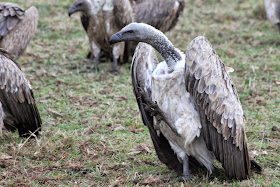The Christmas season is upon us, and what better way to
celebrate with beloved pictures of vultures? Similar to hyenas, these species
are often, to put it lightly, distrusted and hated. Unlike hyenas however,
vultures are not exactly the cutest specimens...Therefore, to spread awareness
and overall holiday cheer, I present some Mara vultures.
 |
| A black-backed jackal digs into a carcass whilst Gypsii vultures stand cautiously nearby. |
We get a chance to see these guys when we find a dead
animal. It may sound less than glamorous, but I personally enjoy the feasting
of dead ungulate. We typically see six species of bird in the Talek part of the
Mara (listed in terms of feeding hierarchy, aka who’s the boss): the
Lappet-faced vulture, the R
üppell’s
vulture (also known as Griffin vulture), the white-backed vulture, the hooded
vulture, the tawny eagle, and the Marabou stork.
 |
| A Lappet-faced vulture rules the roost, you could say. |
 |
| Gypsii vultures, aka white-backed and Griffin vultures. The Griffen have the yellow-ish beaks. |
 |
| The hooded vulture |
 |
| The gorgeous/weak tawny eagle |
 |
| A chatty Marabou stork voices some important thought. |
If hyenas are eating, the vultures look on cautiously
from a safe distance of at least a meter. However, if only one or two hyenas are feeding, the vultures showcase their bravery by jumping at the meat while the hyenas ward them off with snarls and lunges. Otherwise, the birds wait until the hyenas have their fill and then they dive in. Interestingly enough, there is a vulture species hierarchy. The Lappet-faced (the big creepy ones with pink heads) have first dibs. They typically use their strong bills to break open the carcass, preferring to eat the hard tissues like cartilage (the ears are quite tasty apparently), tendons, or even bones. After they have gorged, the
Gypsii vultures take their turn. This
genus of vultures contains the R
üppell's
and the white-backed. They prefer the soft tissues like the fat, muscles, and
inner organs. In fact, the R
üppell’s
and white-backed will often wait for Lappets to crack open that tough carcass
outer hide. But, if the Lappets are really late, the R
üppell’s and the white-backed are sometimes forced to
break through more sensitive areas of the body, the eyes or anus. Hooded
vultures eat next, and lastly, the tawny eagles eat. I’m not sure where the
Marabou storks fit into this hierarchy, but from personal observation I mostly
notice them meandering around the carcass while everyone else eats.
 |
| Bon appétit! |
Additionally, Gypsii
(Rüppell and white-backed) vultures
have been found to follow tawny eagles to carcasses. Most of the time, eagles
are the first to find a dead hunk of meat while the vultures instead scan the
skies for their competitors. Because the vultures are the dominant species, they
can arrive fashionably late and still kick a tawny eagle off the dead carcass
before you can say, “let’s tear open that wildebeest’s anus!” Tawny eagles also
have a stronger bill, which can dig through an ungulate hide, whereas vultures
act more as scroungers (Kane et al.
2014). So unfortunately for the eagles, though they may open the carcass, the vultures tend to get more of the meat.
 |
| A white-backed vulture giving the death stare and marching. |
If you would like to watch vultures devour a dead wildebeest
(no shame, everyone at Fisi camp does) then click play on the attached video.
If you just ate lunch, you may want to pass.
Some of this information came from the following source,
however a lot was relayed to me by a wonderful RA out here, Wilson Kilong, who
worked on a vulture project before studying hyenas. Thanks Wilson, you’re the
best!
Kane, A., Jackson, A.L., Ogada, D.L., Monadjem, A., McNally,
L. 2014. Vultures acquire information on carcass location from scavenging
eagles. Proc. Royal Society. 281:
1793.










Great post, thanks, and Happy Holidays to you and all the fisi campers on duty this year.
ReplyDelete